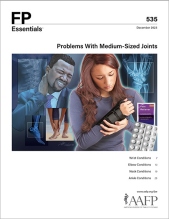
This clinical content conforms to AAFP criteria for CME.
The ankle is the cause of many musculoskeletal injuries. Knowledge of ankle anatomy and physiology can provide an initial framework to help clinicians formulate a differential diagnosis. A thorough history should be obtained, with a focus on mechanism of injury and symptom duration to hone the differential diagnosis and physical examination. Specific diagnostic maneuvers allow for evaluation of individual structures and assessment of ankle stability. The Ottawa Ankle Rules can assess the need for x-rays and help rule out underlying fracture. Lateral and medial ankle sprains and Achilles tendinopathy are among the most common ankle conditions in the primary care setting. These sprains are managed with ankle protection with a splint, brace, or other device; the rest, ice, compression, and elevation (RICE) protocol; and a short course of nonsteroidal anti-inflammatory drugs (NSAIDs). Management of Achilles tendon conditions typically consists of the RICE protocol, activity reduction, physical therapy or clinician-directed exercises, NSAIDs, and, in severe cases, short-term immobilization. For patients with stable ankle fractures, various orthoses can be used for immobilization. Orthopedic consultation should be sought for patients with unstable ankle fractures.
Case 4. JD is a 31-year-old patient who plays in a recreational adult soccer league. During a game, he experienced an inversion ankle injury and reported feeling a pop. He was unable to bear his full weight for more than one step immediately after the injury and is using crutches to walk today. Physical examination reveals anterolateral ankle swelling and bruising over the right lateral ankle. JD reports tenderness on palpation of the distal, posterior lateral malleolus. He says he has had ankle injuries before, but never one this severe.
Subscribe
From $350- Immediate, unlimited access to FP Essentials content
- 60 CME credits/year
- AAFP app access
- Print delivery available
Edition Access
$44- Immediate, unlimited access to this edition's content
- 5 CME credits
- AAFP app access
- Print delivery available
